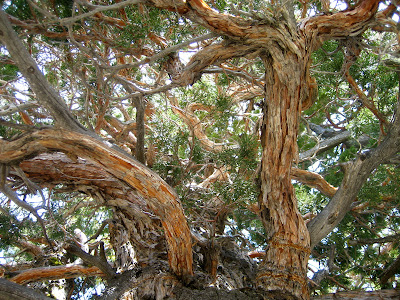
Day 2: Upper montane and subalpine zone of the western Sierra Nevadas
We drove up the western side of the Sierras and stopped several times along the way to see how the vegetation types change with elevation. We drove up through the white fir and red fir dominated forests, all the way up to the subalpine zone at 8,000 feet. It was chilly up there, and the snowballs were flying. The temperatures in Davis have been in the 80s and 90s for the past month so everyone was really excited to see the snow.

The trees in the subalpine zone are really stressed because of high winds and cold temperatures. In the winter, the wind picks up ice from the snow and blows it against the trees, scouring off the branches from the windward side of the trees. The trees are really funny looking because it looks like they only grow branches on one side.

There are a lot of really low-lying plants up there too, and their flowers are disproportionately large. They're called cushion plants because they resemble little pin cushions. This growth form keeps them insulated under the snow in the winter, and keeps them from drying out and getting sunburned from the intense sun.

Juniper trees grow in the subalpine zone, and their bark is beautiful and peeling.


We camped for the night at Grover Hot Springs State Park on the eastern side of the Sierras. There's a pool there that's heated by the hot springs, but you had to pay $5 to get in and wait in line. Plus, it's just a regular pool, so I decided to pass and I played dominoes instead.

Day 3: Eastern side of the Sierra Nevadas
The eastern side of the Sierras is drier than the western side because of the rain shadow created by the mountains. As clouds move east across CA from the ocean, they move up and over the mountains. The atmosphere thins as the clouds move up in elevation, and the water is squeezed out of the clouds to fall on the western slope. As the clouds descend on the eastern side of the mountains, they move down in elevation and expand, sucking up any available moisture. So the western side of the Sierras is a lot wetter than the eastern side. I think that's a really cool phenomenon, but then again, I'm a science nerd.

We also saw an aspen stand on the eastern side of the mountains.


We travel everywhere in these school vans and it cracks me up. People must think that we're a caravan of government vehicles.

So that was the last of the field trips. It was a crazy quarter, but there's only one more week left!




No comments:
Post a Comment